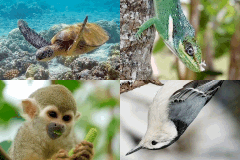AnAge entry for Coturnix japonica
Classification (HAGRID: 00576)
- Taxonomy
-
Kingdom: Animalia
Phylum: Chordata
Class: Aves (Taxon entry)
Order: Galliformes
Family: Phasianidae
Genus: Coturnix
- Species
- Coturnix japonica
- Common name
- Japanese quail
Lifespan, ageing, and relevant traits
- IMR
- 0.07/year
- MRDT
- 1.2 years
- Maximum longevity
- 6 years
- Source
- Multiple references, please see bibliography below
- Sample size
- Medium
- Data quality
- Acceptable
- Observations
The Japanese quail displays a well-defined ageing process. Signs of ageing are visible at little over one year of age. In the wild, these animals generally live 2-3 years [0028].
Life history traits (averages)
- No information is available on life history. Please contact us if you wish to suggest or contribute data.
Metabolism
No information on metabolism is available.
References
- [0797] Ottinger (2007), Neuroendocrine aging in birds: comparing lifespan differences and conserved mechanisms (PubMed)
- [0725] Gupta et al. (2006), DNA methylation induced changes in chromatin conformation of the promoter of the vitellogenin II gene of Japanese quail during aging (PubMed)
- [0519] Ottinger et al. (2005), Effects of calorie restriction on reproductive and adrenal systems in Japanese quail: Are responses similar to mammals, particularly primates? (PubMed)
- [0471] Ottinger et al. (2004), The Japanese quail: a model for studying reproductive aging of hypothalamic systems (PubMed)
- [0062] Holmes and Ottinger (2003), Birds as long-lived animal models for the study of aging (PubMed)
- [0218] Ottinger et al. (2003), Establishing appropriate measures for monitoring aging in birds: comparing short and long lived species (PubMed)
- [0219] Alway (2002), Attenuation of Ca(2+)-activated ATPase and shortening velocity in hypertrophied fast twitch skeletal muscle from aged Japanese quail (PubMed)
- [0217] Ogburn et al. (2001), Exceptional cellular resistance to oxidative damage in long-lived birds requires active gene expression (PubMed)
- [0028] Ottinger (2001), Quail and other short-lived birds (PubMed)
- [0732] Starck and Ricklefs (1998), Avian growth rate data set
- [0220] Ottinger et al. (1997), Neuroendocrine regulation of GnRH and behavior during aging in birds (PubMed)
- [0288] Dietz and Drent (1997), Effect of growth rate and body mass on resting metabolic rate in galliform chicks (PubMed)
- [0221] Upadhyay et al. (1996), Age-related changes in the ovalbumin gene of the Japanese quail (PubMed)
- [0229] Alway (1995), Slowing of contractile properties in quail skeletal muscle with aging (PubMed)
- [0227] Alway (1994), Contractile properties of aged avian muscle after stretch-overload (PubMed)
- [0228] Mishra and Kanungo (1994), Alterations in histones of the liver and oviduct of Japanese quail during aging (PubMed)
- [0002] Caleb Finch (1990), Longevity, Senescence, and the Genome
- [0222] Fite and Bengston (1989), Aging and sex-related changes in the outer retina of Japanese quail (PubMed)
- [0226] Ryals and Westbrook (1988), Ganglion cell and hair cell loss in Coturnix quail associated with aging (PubMed)
- [0223] Ottinger and Balthazart (1986), Altered endocrine and behavioral responses with reproductive aging in the male Japanese quail (PubMed)
- [0224] Ottinger et al. (1983), Age-related reproductive decline in the male Japanese quail (PubMed)
- [0225] Eroschenko et al. (1977), Function and histology of testes from aged coturnix maintained on different photoperiods (PubMed)
- [0694] Woodard and Abplanalp (1971), Longevity and reproduction in Japanese quail maintained under stimulatory lighting (PubMed)
External Resources
- Integrated Taxonomic Information System
- ITIS 176013
- Animal Diversity Web
- ADW account
- Encyclopaedia of Life
- Search EOL
- NCBI Taxonomy
- Taxonomy ID 93934
- Entrez
- Search all databases
- Ageing Literature
- Search Google Scholar or Search PubMed
- Images
- Google Image search
- Internet
- Search Google

